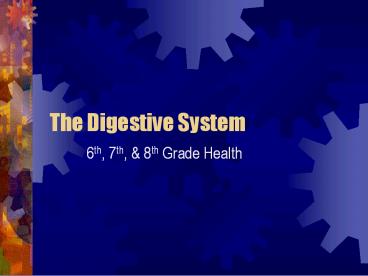The Digestive System - PowerPoint PPT Presentation
1 / 21
Title:
The Digestive System
Description:
The Digestive System 6th, ... Major Functions of the Digestive System Break down ingested food Put nutrients into the bloodstream Remove waste from the body Organs ... – PowerPoint PPT presentation
Number of Views:447
Avg rating:3.0/5.0
Title: The Digestive System
1
The Digestive System
- 6th, 7th, 8th Grade Health
2
Digestive System
Warm-up
- What is the function of the Respiratory System?
- Name the parts of the Respiratory System?
3
Learning Objectives
- To recognise the organs involved in digestion
- To understand the major functions of each body
part in the digestive process - To understand the four major phases of digestion
- To understand the functions of different enzymes.
4
Major Functions of the Digestive System
- Break down ingested food
- Put nutrients into the bloodstream
- Remove waste from the body
5
Organs of the Digestive System
- Mouth- teeth, salivary glands, tongue
- Esophagus
- Stomach
- Small Intestine
- Large Intestine
- Pancreas
- Liver
- Gall bladder
Accessory Organs
6
Mouth
- Digestion begins here!
- Teeth and tongue are used in mechanical
digestion- physical breakdown of food - Saliva and enzymes begin chemical digestion-
chemical breakdown of food
7
Esophagus
- Muscular tube that connects mouth to stomach
- Moves food downward by peristalsis, or muscular
contractions - Epiglottis seals off windpipe during swallowing
to prevent choking
8
Stomach- Mechanical and Chemical Digestion
- Muscular pouch that expands to hold your food
- Hydrochloric acid (HCl) and the enzyme pepsin
combine to form gastric juice
9
Stomach- Mechanical and Chemical Digestion
- A gummy coating of mucus protects the stomach
lining from the strong chemicals - Chyme, a thick liquid containing partially
digested food, is produced here
10
Small Intestine
- Most chemical digestion occurs here!
- Inner surface is covered in villi and microvilli,
millions of tiny finger-like projections that
absorb nutrient molecules from the chyme - The villi create a large surface area, so as
- many nutrients as possible can be absorbed
11
Other Facts of the Small Intestine
- Longest portion of the digestive tract
- Tube that is 20- 25 feet long
- Food stays in your small intestine for 4 to 8
hours
12
Liver
- Makes bile to break up fat
- Stores nutrients, like vitamins and sugars until
your body needs them - Breaks down toxins
13
Gallbladder
- Temporarily stores bile and releases it into the
small intestines - Storage tank for bile (a greenish-yellow liquid)
- Helps your body break down and use fats
- Located under your liver
- Shaped like a pear
14
Pancreas
- Makes digestive enzymes
- Makes hormones that regulate sugar levels
- Helps you digest food by breaking down sugars
15
Large Intestine
- No digestion occurs here
- Water is absorbed from remaining food
- Bacteria feed on material passing through and
produce Vitamins (K) vital to our health - Waste material, feces, is prepared for
elimination from the body
16
Other Facts of the Large Intestine
- Tube that is 5 feet long
- Gets waste from small intestine
- Waste stays for 10 to 12 hours
17
Rectum
- Stores feces until they can be expelled through
the anus.
18
Large Intestine
19
Videos
- http//www.neok12.com/video/Digestive-System/zX455
9475700465170435873.htm - http//kidshealth.org/kid/htbw/DSmovie.html
20
Some more videos
- http//www.youtube.com/watch?vP5lyQUtq1KQ
- http//kidshealth.org/kid/htbw/_bfs_DSmoviesource.
html - http//www.youtube.com/watch?vq3986Yfl5cU
- http//kitses.com/animation/swfs/digestion.swf
21
The End!































